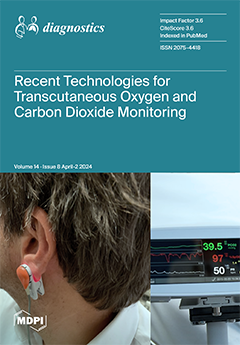Open AccessReview
Multi-Modality Imaging in Vasculitis
by
Mohamed N. Allam, Nima Baba Ali, Ahmed K. Mahmoud, Isabel G. Scalia, Juan M. Farina, Mohammed Tiseer Abbas, Milagros Pereyra, Moaz A. Kamel, Kamal A. Awad, Yuxiang Wang, Timothy Barry, Steve S. Huang, Ba D. Nguyen, Ming Yang, Clinton E. Jokerst, Felipe Martinez, Chadi Ayoub and Reza Arsanjani
Viewed by 460
Abstract
Systemic vasculitides are a rare and complex group of diseases that can affect multiple organ systems. Clinically, presentation may be vague and non-specific and as such, diagnosis and subsequent management are challenging. These entities are typically classified by the size of vessel involved,
[...] Read more.
Systemic vasculitides are a rare and complex group of diseases that can affect multiple organ systems. Clinically, presentation may be vague and non-specific and as such, diagnosis and subsequent management are challenging. These entities are typically classified by the size of vessel involved, including large-vessel vasculitis (giant cell arteritis, Takayasu’s arteritis, and clinically isolated aortitis), medium-vessel vasculitis (including polyarteritis nodosa and Kawasaki disease), and small-vessel vasculitis (granulomatosis with polyangiitis and eosinophilic granulomatosis with polyangiitis). There are also other systemic vasculitides that do not fit in to these categories, such as Behcet’s disease, Cogan syndrome, and IgG4-related disease. Advances in medical imaging modalities have revolutionized the approach to diagnosis of these diseases. Specifically, color Doppler ultrasound, computed tomography and angiography, magnetic resonance imaging, positron emission tomography, or invasive catheterization as indicated have become fundamental in the work up of any patient with suspected systemic or localized vasculitis. This review presents the key diagnostic imaging modalities and their clinical utility in the evaluation of systemic vasculitis.
Full article
►▼
Show Figures






